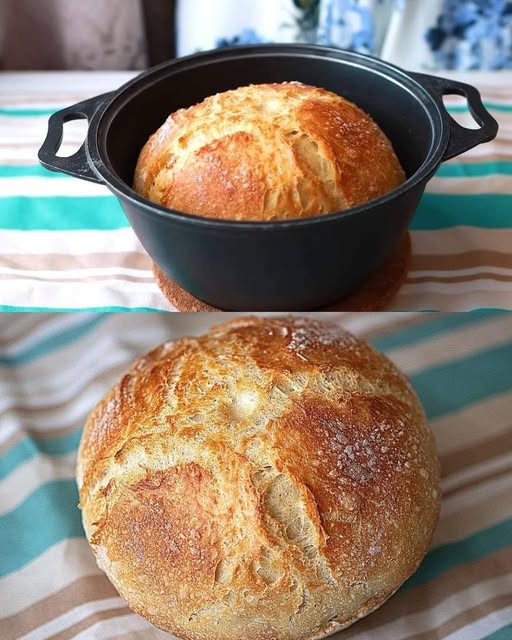4 Ingredients Only Homemade Bread
There is something incredibly comforting about the aroma of freshly baked bread drifting through the house. Many people assume that homemade bread is complicated or requires special tools, but this simple four-ingredient loaf proves the opposite. With nothing more than warm water, yeast, flour, and salt, you can create a soft, rustic loaf that tastes better than anything from the store. It is the kind of recipe anyone can prepare, whether you are new to baking or simply looking for a reliable everyday bread.
The beauty of this bread lies in its simplicity. Each ingredient plays a clear role. Warm water activates the yeast and brings the dough together. Yeast gives the bread its lift and airy texture. Flour provides the structure. Salt adds flavor and balances the natural sweetness that develops as the dough rises. When these four ingredients combine, they create a loaf that is both light and satisfying.
One of the reasons this recipe is so friendly for beginners is that it does not require complicated kneading. A gentle mix is often enough to bring the dough together. The long rising time allows the gluten to develop naturally, creating a soft interior with little work. As the dough rests, it grows in size and develops the subtle flavors that make homemade bread so special.
Below is a full guide to preparing this simple, warm loaf at home using only four basic ingredients.
Ingredients
Warm water: 1 ½ cups (370 ml)
Dry yeast: 2 tablespoons (10 g)
Flour: 4 cups (500 g)
Salt: 1 teaspoon
Instructions
Begin by preparing the yeast mixture. Pour the warm water into a large mixing bowl. The water should be warm but not hot to the touch. Add the dry yeast and stir lightly. Allow the mixture to sit for about ten minutes. During this time, the yeast will begin to foam on the surface, a sign that it is active and ready to work. This step ensures a good rise later.
Once the yeast has activated, add the salt and begin adding the flour gradually. Stir with a wooden spoon or your hand until the dough starts to come together. You want a soft, slightly sticky dough. If it feels too wet, you can add a little more flour, one spoon at a time. If it feels too dry, a splash of water will bring it back to the right texture.
When the dough has formed, cover the bowl with a clean cloth or plastic wrap. Let it rise in a warm place for about one to two hours. As it rests, the dough will double in size. This step is where the magic happens. The yeast creates small pockets of air, giving the bread its soft and fluffy texture. You will notice the dough becoming lighter and more elastic over time.
After the first rise, sprinkle a little flour onto your work surface and gently turn the dough out. At this point, you do not need to knead aggressively. Simply fold the dough a few times to shape it into a round or oval loaf. Place the shaped dough onto a baking tray lined with parchment paper. Cover it again and allow it to rise for another thirty minutes while the oven heats.
Preheat your oven to 220°C (425°F). A hot oven helps the bread rise quickly once baking begins. When the dough has finished its second rise, use a sharp knife to make one or two shallow cuts on top. These cuts allow the bread to expand evenly in the oven and also give it a rustic appearance.
Place the bread in the oven and bake for about twenty-five to thirty minutes. The top should turn a beautiful golden brown. To check if the bread is done, tap the bottom gently. A hollow sound indicates that the inside is fully baked. Remove the loaf from the oven and place it on a rack to cool. Allowing it to cool before slicing helps the interior set properly.
This bread is incredibly versatile. Its soft crumb and gentle flavor make it perfect for warm buttered slices, sandwiches, toast, or even as a base for garlic bread. You can serve it with soups, stews, or simply enjoy it fresh from the oven. Because the recipe is so simple, it also invites variation. If you ever want to add herbs, cheese, or seeds, you can build on this basic version. But even in its pure form, it stands out for its taste and texture.
This four-ingredient bread shows how accessible homemade baking can be. It requires no special equipment, no kneading machines, and no advanced techniques. Just patience, warmth, and a little time. The result is a wholesome loaf that feels rewarding to make and even more enjoyable to eat.
Making your own bread brings a sense of satisfaction that store-bought loaves cannot offer. You know exactly what goes into it, and you control the texture and shape. With this simple recipe, anyone can enjoy the experience of creating homemade bread from scratch, proving that good food does not need to be complicated or expensive
